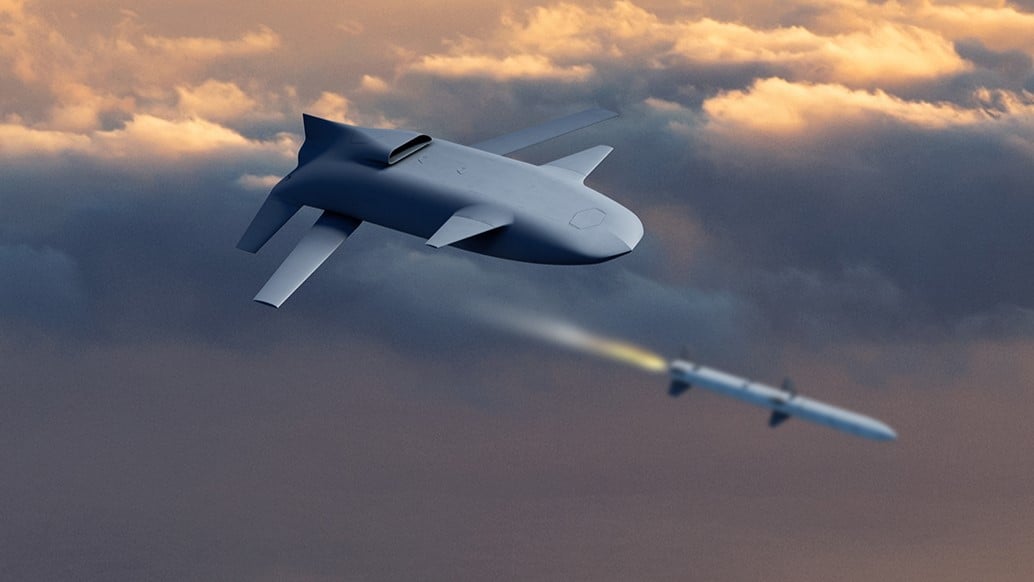The US Defense Advanced Research Projects Agency has awarded General Atomics a contract, as a part of its LongShot program, to develop an unmanned aircraft system that can be deployed from a bomber or fighter and can launch missiles independently.
On September 7, General Atomics Aeronautical Systems, the sole awardee for the next phase of the LongShot program, announced its selection and stated its expectation to initiate flight testing of this drone by the end of the year.
Mark Brinkley, GA-ASI’s Senior Director of Strategic Communications and Marketing, said, “General Atomics was competitively awarded a contract to develop DARPA’s concept for disruptive air combat operations through demonstration of an air-to-air weapons capable air vehicle.”
“The concept seeks to significantly increase engagement range and mission effectiveness of current 4th gen fighters and air-to-air missiles,” Brinkley added.
Brinkley also mentioned that the flight testing will confirm essential vehicle handling characteristics and establish the groundwork for subsequent development and testing phases.
In February 2021, General Atomics was selected, along with Northrop Grumman and Lockheed Martin, to contribute preliminary designs for the initial phase of the LongShot program.
Subsequently, in March 2022, General Atomics emerged as the sole recipient of the award for phase 2, and once again, it secured the exclusive contract for phase 3 of the project.
In its recent announcement, GA-ASI also unveiled concept art that presents a striking departure from the design showcased by the company in 2021.
The updated rendering depicts an uncrewed aircraft featuring significant changes, including an elongated fuselage, petite canards at the front, reverse-swept main wings toward the rear, and an inverted V-shaped twin-tail setup.

Notably, the main wings appear to be engineered for post-launch deployment. Additionally, the aircraft incorporates a streamlined tail-like extension positioned behind a top-mounted dorsal engine air intake and a chined nose for enhanced aerodynamic performance.
In the new LongShot artist’s rendering, the drone is depicted launching an AIM-120 Advanced Medium Range Air-to-Air Missile (AMRAAM).
It remains uncertain whether the drone intends to carry these missiles externally or within an internal bay, as in the 2021 design. Additionally, the image includes a Boeing F-15 fighter in US Air Force livery in the background.
LongShot Aircraft-Launched Air-To-Air Combat Drone
In the realm of military technology, the pursuit of innovative drone design has taken center stage among Pentagon leaders. This emphasis is exemplified by Deputy Secretary of Defense Kath Hicks, who recently unveiled the ambitious “Replicator” initiative.
Under this program, the Pentagon aims to acquire thousands of drones spanning various operational domains within 18 to 24 months.
DARPA’s LongShot program aligns seamlessly with this overarching vision, signaling the growing importance placed on next-generation aerial combat capabilities.
DARPA considers LongShot, a turducken-like unmanned aircraft system capable of being deployed from a bomber or fighter to launch its missiles, as having potential value for both the Air Force and Navy.
In a February 2021 announcement, DARPA outlined its objective to create an innovative UAV (Unmanned Aerial Vehicle) designed to substantially enhance engagement ranges, improve mission effectiveness, and decrease the risk to crewed aircraft.
The vision for LongShot is to enhance the survivability of manned platforms by enabling them to operate at safe standoff distances, well clear of potential enemy threats. Simultaneously, the air-launched LongShot UAV is expected to adeptly bridge the gap, closing in on targets to facilitate more precise and effective missile strikes.
This approach leverages a slower-moving, fuel-efficient air vehicle for ingress while preserving potent air-to-air missiles for precise target engagement in the final phase. This, in turn, will offer numerous advantages that boost the weapon’s effectiveness.
This initiative will tackle the complexities of launching air-to-air missiles from a comparatively compact UAV within real-world operational conditions, focusing on stability and control concerns.
As previously mentioned, LongShot will be capable of launching either from a manned aircraft or being carried by bombers, enhancing their anti-air capabilities significantly.
In the scenario where it’s launched from a bomber, LongShot’s deployment would be triggered by detecting hostile fighters through allied battle networks rather than solely relying on the bomber’s onboard sensors.
This approach effectively substitutes LongShot for a manned fighter escort, safeguarding the bomber and freeing up fighters for other mission priorities.
While the primary objective is to integrate LongShot into existing bombers like the B-52H, there’s also a precise aim to incorporate it into the forthcoming B-21 Raider stealth bomber, with an emphasis on ensuring it can be accommodated within the bomber’s weapons bay for added operational flexibility and effectiveness.
In summary, LongShot appears to present a range of possibilities for augmenting the air combat capabilities of both manned and unmanned aircraft, all while potentially offering cost-effective solutions.
- Contact the author at ashishmichel(at)gmail.com
- Follow EurAsian Times on Google News